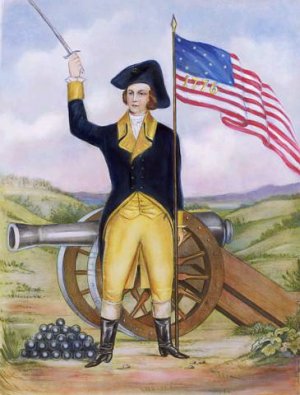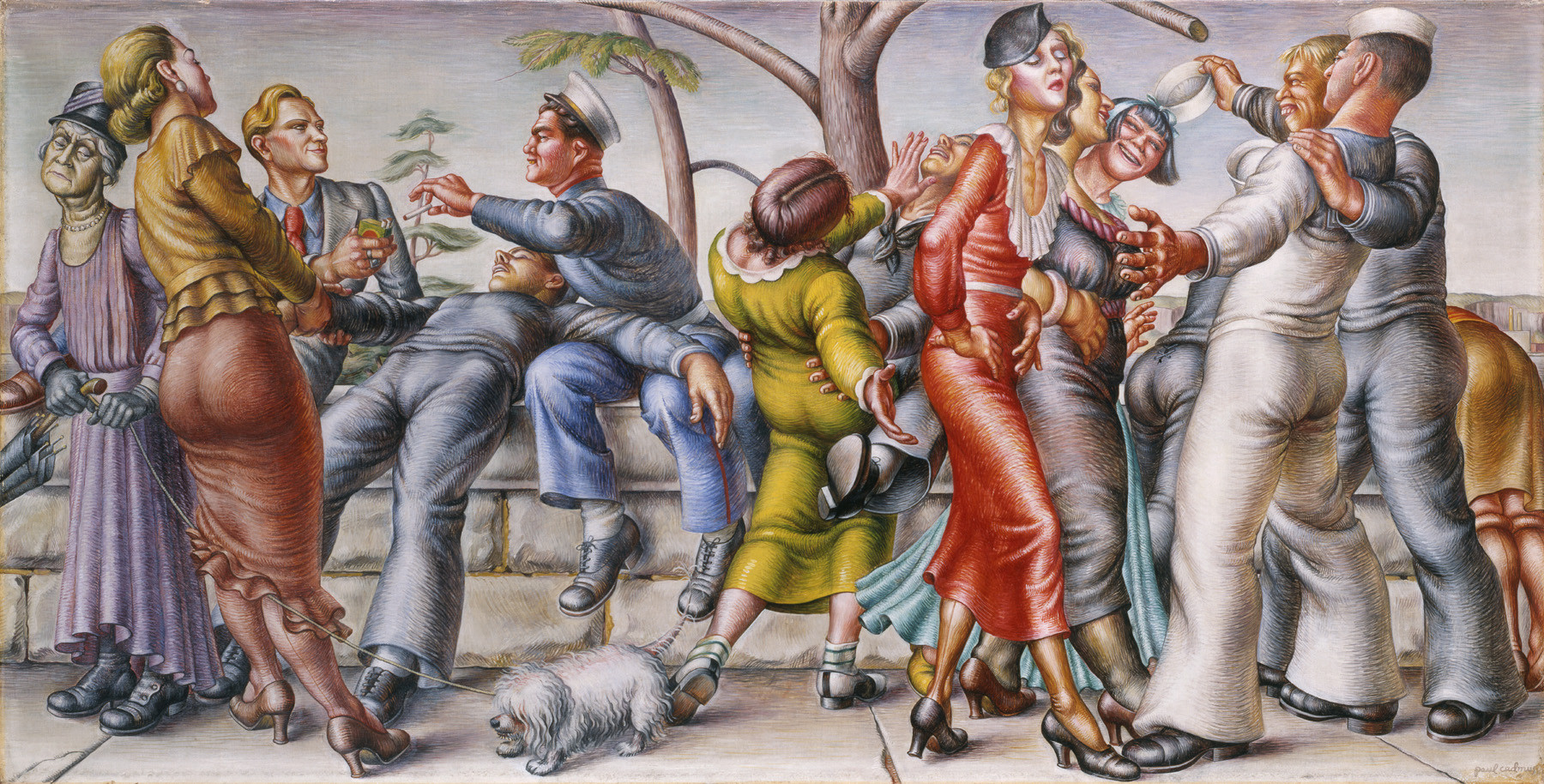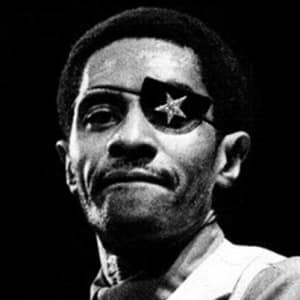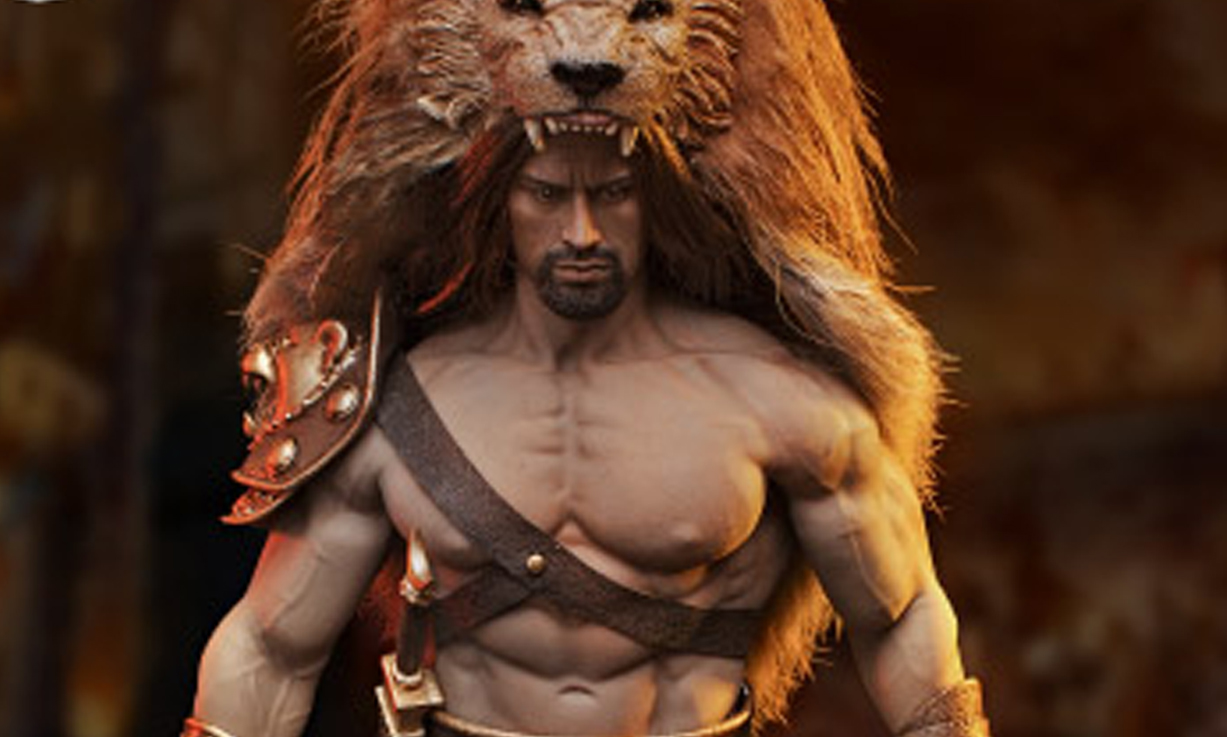December 17
DEBORAH SAMPSON, born (d: 1827) was the first known American woman to impersonate a man to join the Army and take part in combat. Masquerading as “Robert Surtlieff,” she was the most famous female soldier of the American Revolution. Though her motives in fighting were patriotic, she had always shown great delight in wearing men’s clothing and in drinking “with the boys.” For both those “offenses,” in fact, she had been excommunicated from the First Baptist Church of Middleborough, Mass. While in the army, Sampson developed a bit of a reputation as a ladies’ man, and the stories of her exploits with women are too numerous to be anything but apocryphal. After serving seventeen months in the Continental Army (and being wounded in the Battle of Tarrytown), Deborah Sampson was discharged by General Henry Knox at West Point.
Eight years later, in January 1792, she petitioned the Massachusetts State Legislature for back pay, which the army had withheld from her, since she was a woman. Her petition passed through the Senate and was approved, then signed by Governor John Hancock. The General Court of Massachusetts verified her service and wrote that she "exhibited an extraordinary instance of female heroism by discharging the duties of a faithful gallant soldier, and at the same time preserving the virtue and chastity of her sex, unsuspected and unblemished". The court awarded her a total of thirty-four pounds.
Ten years after that, in 1802, began giving lectures about her experiences in the army. She was not only the first American female to cross-dress at the time war, but she was also the first woman to give a lecture. Deborah enjoyed speaking about serving her country. These speeches were initiated due to her own financial needs as well as a desire to justify her enlistment. But even with these speaking engagements, she was not making enough money to pay her expenses. She had to borrow money from her family and from her friend Paul Revere on many occasions. The soldiers in the Continental Army had received pensions for their services, but Sampson did not because she was female.
In 1804, Paul Revere wrote to Massachusetts' representative, William Eustis, on Sampson's behalf. Revere requested that Congress grant her a military pension. This had never before been requested by or for a woman, but with her health failing and family being destitute, the money was greatly needed. Revere wrote, "I have been induced to enquire her situation, and character, since she quit the male habit, and soldiers uniform; for the most decent apparel of her own sex; and obliges me to say, that every person with whom I have conversed about her, and it is not a few, speak of her as a woman with handsome talents, good morals, a dutiful wife, and an affectionate parent." On March 11, 1805 Congress in Washington obliged the letter, and placed her on the Massachusetts Invalid Pension Roll. This pension plan paid her four dollars a month.
PAUL CADMUS, American artist, born (d. 1999); Best known for his paintings and drawings of nude male figures, Cadmus’s works combined elements of eroticism and social critique to produce a style often called magic realism. He painted with egg tempera, a medium which had been associated with Greek icons. If there ever was a painter who could render the male ass more erotic than Paul Cadmus, this writer has never seen it. His unique blending of realism and sexual playfulness shocked viewers in the 1930s, and The Fleet’s In, Cadmus’s suggestion of naval sexuality, caused a scandal when the U.S. Navy order the painting seized. All he had done to cause such a ruckus was to paint well-developed men in tight-fitting Navy uniforms and to suggest they might be interested in a couple of young women. That sailors were in pursuit of sex put the Navy in a snit. But the scandal — written up in every newspaper and magazine — made Cadmus’s career. The Navy should have seen the many other works in which the sailors obviously wanted each other!
He worked in commercial illustration as well, but Jared French, another tempera artist who befriended him and became his lover, convinced him to devote himself completely to fine art. Other early works of particular interest for their homoeroticism are YMCA Locker Room (1933), Shore Leave (1933), and Greenwich Village Cafeteria (1934). Like The Fleet's In!, these works also document homosexual cruising and seduction.
In Cadmus's paintings, significant exchanges of glances signal sexual longing and availability, often in the very midst of mundane activities. His work documents the surreptitious cruising rituals of an urban, gay male subculture in the 1930s.
Cadmus's painting What I Believe (1947-1948) was inspired by E.M. Forster's essay of the same name, in which the novelist expresses his faith in personal relations and his concept of a spiritual aristocracy "of the sensitive, the considerate, and the plucky. Its members are to be found in all nations and classes, and all through the ages, and there is a secret understanding between them when they meet. They represent the true human condition, the one permanent victory of our queer race over cruelty and chaos."
He lived with his companion of 35 years, Jon Anderson, who was a subject of many of his works.
JAMES BOOKER (d: 1983) was a New Orleans rhythm and blues musician born on this date in New Orleans. Booker's unique style combined rhythm and blues with jazz standards. Harry Connick Jr., a student and close friend of Booker, is probably his most renowned disciple. Connick, Henry Butler, and Dr. John (who proclaimed Booker 'the best black, gay, one-eyed junkie piano genius New Orleans has ever produced'), among others, have recorded songs with titles and musical styles referencing Booker.
Booker was the son and grandson of Baptist ministers, both of whom played the piano. He spent most of his childhood on the Mississippi Gulf Coast, where his father pastored a church. Booker received a saxophone as a gift from his mother, but he demonstrated a stronger interest in the keyboard. He first played organ in his father's churches.
Booker was highly skilled in classical music and played Bach and Chopin, among other composers. He also mastered and memorized solos by Erroll Garner and Liberace. His thorough background in piano literature may have enabled his original and virtuosic interpretations of jazz and other popular music. These performances combined elements of stride, blues, gospel and Latin
Booker made his recoring debut in 1954 on the Imperial Label, with "Doin' the Hambone" and "Thinkin' 'Bout My Baby." This led to some session work with Fats Domino, Smiley Lewis and Lloyd Price.
In 1958, Arthur Rubenstein gave a concert in New Orleans. Afterwards, eighteen-year-old Booker was introduced to the concert pianist and played several tunes for him. Rubinstein was astonished, saying "I could never play that... never at that tempo! Booker also became known for his flamboyant personality amongst his peers.
After recording a few other singles, he enrolled as an undergraduate in Southern University’s music department. In 1960, Booker's "Gonzo" reached number 43 on the U.S. Billboard chart, and number 3 on the R&B chart. This was followed by some moderately successful singles. In the 1960s, he turned to drugs, and in 1970 served a brief sentence in Angola Prison for possession.
In 1973 Booker recorded The Lost Paramount Tapes at Paramount Studios in Hollywood with members of the Dr. John band which included John Boudreaux on drums, Jessie Hill on percussion, Alvin Robinson on guitar and vocals, Richard "Didymus" Washington on percussion, David Lastie on sax and Dave Johnson on bass. This album was produced by the former Dr. John and Sweathog bassist, David L. Johnson and Daniel J. Moore. The master tapes disappeared from the Paramount Recording Studios library, but a copy of some of the mixes made near the time of the recordings was discovered in 1992, which resulted in a CD release.
Booker recorded a number of albums while touring Europe in 1977, including New Orleans Piano Wizard Live! which was recorded at his performance in the 'Boogie Woogie and Ragtime Piano Contest' in Zurich, Switzerland. This album won the Grand Prix du Disque. He played at the Nice and Montreuz Jazz Festivals in 1978. Fourteen years later a recording in Leipzigfrom this tour would become the last record to be produced in the former East Germany. It was entitled Let's Make A Better World!.
From 1977 to 1982 he was the house pianist at the Maple Leaf Bar in the Carrollton neighborhood of uptown New Orleans.
His last commercial audio recording, Classified, was made in 1982 — in four hours according to the producer. By this time, his physical and mental condition had deteriorated. One anecdote to illustrate his state of deterioration: he famously came on stage at a concert wearing nothing but a diaper with a large gold diaper pin holding the nappy together. He reached into the back of the diaper and pulled out a gun, announcing “I know someone out there has some, and if they don’t bring me some coke I’m going to blow my brains out!”
At the end of October, 1983, film-maker Jim Gabour captured Booker's final concert performance. The footage from the Maple Leaf Bar in New Orleans was broadcast on Cox Cable and a six-and-a-half-minute improvisation, "Seagram's Jam," featured on Gabour's film - All Alone with the Blues.
Booker died ten days later, on November 8, 1983, while seated in a wheelchair, waiting to be seen at the emergency room at New Orleans Charity Hospital. The cause of death was renal failure. His death was mourned by music lovers, but was unsurprising to those who were aware of his life-long history of serious drug abuse and chronic alcoholism.
It has been speculated that his song "Gonzo" was the inspiration for the use of the word gonzo to describe Hunter S. Thompson's journalistic style.
A feature-length documentary entitled "Bayou Maharajah" was produced on the life of James Booker, released in 2013.
TODAY'S GAY WISDOM
Apropos of Cadmus’s mythopoetic painting and since this is the time of year of major Western European myths (based largely on Middle Eastern myths, over-layed on Pagan celebrations) we thought it would be fun to continue this week with some of the classic love affairs among the gods.
Hercules and His Lovers
Hercules was not only the strongest of the heroes (even as a baby he killed two great serpents with his bare hands) but he was also the craziest (he murdered his first three sons in a fit of madness) and the smartest (what he could not accomplish by brute strength he achieved through guile). What is less well known these days is that he was as heroic in bed as he was standing up.
One time he was invited by king Thespios to help him rid the land of a huge lion that was terrorizing the countryside. When the king set eyes on Hercules he had a better idea: "Come and stay the night at my palace, and rest yourself before the hunt," said the king to Hercules, "and meet my family." As Hercules was soon to find out, the king's family was made up mostly of his fifty virgin daughters, for whom he had not found fitting husbands until then. That night Hercules met them all, and made love to forty nine of them (the fiftieth was too shy). The next morning, he and the king went off to hunt the lion, and nine months later all forty-nine daughters gave birth to sons.
In the time-honored manner of his culture, much as he loved women, Hercules loved young men no less. Plutarch said that the number of his lovers was beyond counting. What we know for sure is that he had more than even the god Apollo (who was no slouch when it came to male love). Most stories about the beloved boys of Hercules have been lost or destroyed, but among his lovers were said to be the young heroes Admetos, Iphitos, and Euphemos, all of them Argonauts, Elacatas, honored by the yearly Elacatia games in Sparta, and Abderus, an Opian boy and son of Hermes, whose love for Hercules cost him his life, and who was honored with his own festival in the city that bore his name.
He was the young man to whom Hercules entrusted the man-eating mares of king Diomedes. Not strong enough to keep them in check, they tore him to shreds and devoured him. Heartbroken, Hercules built the city of Abdera in his memory. There was also a myth, now lost, that claimed that Eurystheus, the king for whom Hercules performs his labors, was one of his lovers, and that Hercules undertook the labors in order to please him. If so, then male love becomes the central motive force of the Hercules cycle, just as the love between Achilles and Patroclos is the fire that drives the story of the Iliad.
Also among his lovers, and not so unlucky, were Philoctetes who inherited Hercules's bow and arrows, and who was called upon to use them in the Trojan war, and Nestor, the youngest son of king Neleus, whom he grew to love more than any other lad. Nireus, Adonis, Jason, Corythus, Stychius, and Phrynx were reputed to have been amongst his lovers as well. But these stories have been lost.
Of all his boyfriends however, the ones he loved the best (besides Nestor) were Iolaos of Thebes, and Hylas of Argos. Iolaos, was also his nephew and, though only sixteen, his helper in many of his labors. It was said that their love was such that Hercules found those labors easier when Iolaos watched him. He was Hercules' charioteer and beloved, just like Patroclos was for Achilles.
As Plutarch tells us: "And as to the [male] loves of Hercules, it is difficult to record them because of their number; but those who think that Iolaos was one of them do to this day worship and honor him, and make their loved ones swear fidelity at his tomb." And also, "It is a tradition likewise that Iolaos, who assisted Hercules in his labors and fought at his side, was beloved of him; and Aristotle observes that even in his time lovers pledged their faith at Iolaos' tomb." The Thebans thought so highly of Iolaos that they worshiped him together with Hercules, named their gymnasium after him, and in his honor held yearly contests, the Iolaeia.
As for the love between Hercules and Hylas, the poet Theocritus, who wrote 300 years before our era, had this to say: "We are not the first mortals to see beauty in what is beautiful. No, even Amphitryon's bronze-hearted son, who defeated the savage Nemean lion, loved a boy-charming Hylas, whose hair hung down in curls. And like a father with a dear son he taught him all the things which had made him a mighty man, and famous.
And they were inseparable, being together both day and night. That way the boy might grow the way he wanted him to, and being by his side attain the true measure of a man. When Jason sailed after the golden fleece, and all the nobles went with him invited from every city, to rich Iolkos he came too, the man of many labors, son of noble Alcmena.
And brave Hylas in the flower of youth went with him aboard the Argo, the strong-thwarted ship, to bear his arrows and to guard his bow."
Subscribe to Gay Wisdom
Would you like to have Today in Gay History (aka Gay Wisdom) sent to you daily?




